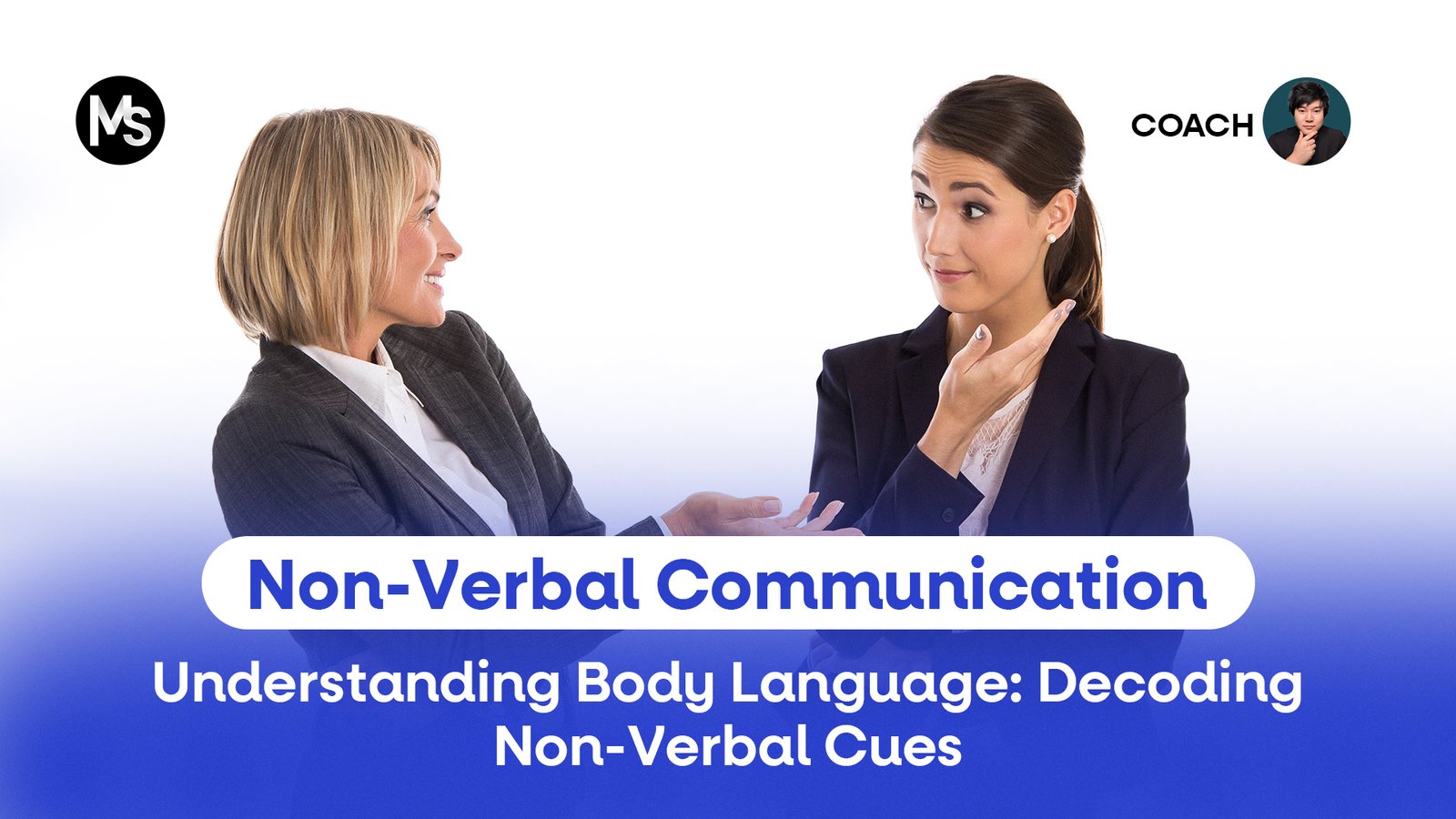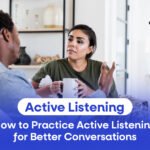Have you ever had a gut feeling that someone’s words didn’t quite match their true intentions? Chances are, you were picking up on their non-verbal communication. Often referred to as body language, this silent language speaks volumes, frequently revealing more than words ever could. It’s a powerful, often unconscious, exchange of signals that forms a critical part of how we understand each other.
Understanding non-verbal cues is an essential part of your foundational communication skills. It allows you to decode unspoken messages, build stronger rapport, and project confidence and trustworthiness. In fact, when there’s a conflict between what someone says and how they say it with their body, we often believe the body language.
In this comprehensive guide, we’ll unveil the secrets of body language, exploring its key elements and providing actionable non-verbal communication tips to help you effectively decode these subtle cues and project the messages you intend.
What is Non-Verbal Communication? The Silent Language
Non-verbal communication is the process of conveying messages without using spoken words. Instead, it relies on a diverse range of physical actions, cues, and mannerisms. Think of it as the unwritten script of human interaction.
While verbal communication uses words, non-verbal signals involve:
- Physical actions: Your posture, gestures, and movements.
- Facial expressions: The subtle shifts on your face that convey emotion.
- Eye movements: How and where you look.
- Proxemics: The use of personal space.
- Paralanguage: Aspects of voice other than words, like tone, pitch, and volume (though often linked closely to verbal, it’s a non-verbal cue in itself).
Unlike conscious verbal statements, non-verbal cues are often involuntary, making them powerful indicators of true feelings and intentions. They can reinforce, contradict, substitute, or regulate spoken messages, creating a rich tapestry of meaning in every interaction.
The Power of Non-Verbal Cues: Why Body Language Matters
The impact of body language is profound. Mastering non-verbal communication isn’t just about reading others; it’s about understanding how you’re perceived and using your own cues effectively.
- Conveys Emotions & Intentions: Non-verbal signals frequently betray feelings that words might try to hide—nervousness, sincerity, anger, excitement, or discomfort. A forced smile, for instance, often contradicts cheerful words.
- Builds & Damages Rapport: Open and inviting body language fosters trust and connection, while closed-off signals (like crossed arms or turning away) can create distance and suspicion.
- Influences Perception: Your non-verbal presence shapes how others perceive your confidence, authority, approachability, and trustworthiness even before you utter a single word.
- Regulates Conversations: Subtle cues like leaning in, making direct eye contact, or shifting posture can signal readiness to speak, listen, or end a conversation.
- Reinforces Verbal Messages: When your gestures, facial expressions, and vocal tone align with your words, they amplify your message, making it more impactful and believable.
- Reveals Truth: When there’s a discrepancy between verbal and non-verbal signals, people tend to believe the non-verbal. It’s often considered a more honest reflection of true feelings.
Key Elements of Non-Verbal Communication (Understanding & Using Cues)
To truly understand and utilize body language, let’s break down its primary components. By observing and consciously applying these, you can significantly enhance your communication skills.
1. Eye Contact: The Windows to the Soul
Your eyes are incredibly expressive. Eye contact is one of the most powerful non-verbal cues.
- Understanding:
- Direct Gaze: Often signals honesty, confidence, interest, or even challenge.
- Avoiding Eye Contact: Can suggest discomfort, deceit, shyness, or lack of confidence.
- Excessive Staring: Can be perceived as aggressive, intimidating, or creepy.
- Using:
- Maintain appropriate eye contact – usually 60-70% of the time in Western cultures. Adapt to cultural norms, as meanings vary significantly.
- Use it to convey focus and engagement, especially when actively listening. Break gaze occasionally to avoid staring.
2. Facial Expressions: The Universal Communicator
Your face is a canvas for your emotions. Many facial expressions are universal across cultures.
- Understanding:
- Universal Emotions: Happiness, sadness, anger, surprise, fear, and disgust are often reflected similarly across different people.
- Micro-expressions: Fleeting, involuntary facial expressions that can reveal true feelings, even when someone tries to hide them.
- Using:
- Ensure your facial expressions align with your message (congruence). A genuine smile conveys warmth; furrowed brows show concern.
- Practice mirroring appropriate emotions when interacting with others to show empathy.
3. Gestures: Emphasizing and Explaining
Gestures are movements of your hands, arms, and other body parts that accompany speech.
- Understanding:
- Open Palms: Often signal honesty and openness.
- Crossed Arms: Can indicate defensiveness, resistance, or a closed mind.
- Fidgeting: May suggest nervousness, boredom, or impatience.
- Pointing: Can be perceived as aggressive or accusatory in some contexts.
- Using:
- Use purposeful, open gestures to emphasize points in your verbal communication and appear more engaging.
- Avoid excessive, distracting, or defensive body movements. Keep your hands visible and avoid hiding them.
4. Posture & Stance: Your Body’s Silent Statement
The way you hold your body says a lot about your attitude and emotional state.
- Understanding:
- Upright Posture: Often conveys confidence, authority, and engagement.
- Slouching: Can signal boredom, lack of interest, or low self-esteem.
- Closed Postures: Like crossed arms and legs, can indicate defensiveness or disinterest.
- Leaning In: Shows interest and engagement.
- Using:
- Maintain an open, relaxed, yet upright posture to project confidence and approachability.
- Adapt your stance to show engagement and respect in different situations (e.g., standing tall when presenting, leaning slightly forward when listening intently).
5. Proximity (Personal Space): Respecting Boundaries
Personal space refers to the physical distance people maintain between themselves and others.
- Understanding: Different cultural norms dictate appropriate distances for various relationships (intimate, personal, social, public zones). Invading someone’s personal space can cause discomfort or even aggression.
- Using:
- Be aware of and respect individual and cultural boundaries regarding personal space.
- Adjust your distance based on the relationship and context. In most professional settings, a social distance (4-12 feet) is appropriate for groups, while a personal distance (1.5-4 feet) is common for closer interactions.
6. Touch: The Most Powerful (and Riskiest) Cue
Touch in communication (haptics) is a powerful non-verbal cue that carries significant weight, depending on the context and relationship.
- Understanding: A handshake conveys greeting or agreement, a pat on the back can signal encouragement, while other forms of touch can convey affection, dominance, or aggression.
- Using:
- Use touch judiciously and always with keen awareness of cultural norms and individual comfort levels.
- A firm, confident handshake is widely accepted in many professional settings as a sign of respect and professionalism.
7. Appearance: Your First Impression
Your clothing, grooming, and personal presentation send immediate signals before you even speak.
- Understanding: Your appearance in communication influences initial judgments about your professionalism, attention to detail, credibility, and respect for the situation.
- Using:
- Dress appropriately for the occasion and your audience.
- Ensure good grooming. Your overall appearance sets the stage and can enhance or detract from your message.
Reading Body Language: Deciphering the Unspoken
While understanding your own body language is crucial, interpreting others’ non-verbal cues can give you invaluable insights:
- Look for Clusters: Don’t rely on a single gesture. Instead, look for groups of cues that point to the same emotion. For instance, crossed arms plus a frown plus leaning away strongly suggests defensiveness.
- Context is Key: A gesture can mean different things in different situations. Rubbing your eyes might mean tiredness or disbelief, depending on the conversation.
- Baseline Behavior: Learn an individual’s normal behavior to spot deviations. A typically animated person becoming suddenly still might be significant.
- Cultural Differences: Be constantly mindful that meanings of gestures, eye contact, and personal space can vary wildly across cultures. What’s polite in one place could be offensive in another.
- Listen Actively: Always combine your observation of non-verbal cues with keen active listening to get a complete and accurate understanding of the message.
Ensuring Congruence: Aligning Words and Body Language
The most effective communicators ensure congruence – that their verbal message aligns with their non-verbal message. When your words say one thing and your body says another, your non-verbal cues are usually believed. This can lead to mistrust or confusion.
To achieve congruence, cultivate self-awareness, allow your genuine emotions to surface appropriately, and practice authenticity. This alignment makes you appear more credible and trustworthy.
Common Non-Verbal Mistakes & How to Avoid Them
Being aware of these common pitfalls can help you refine your body language:
- Closed-Off Posture: Crossing arms or legs, turning your body away. Solution: Keep an open, relaxed posture.
- Lack of Eye Contact: Appearing shifty, shy, or uninterested. Solution: Maintain appropriate, consistent eye contact.
- Fidgeting/Restlessness: Tapping fingers, shifting weight, playing with objects. Suggests nervousness, impatience, or boredom. Solution: Be mindful of your movements; channel nervous energy into purposeful gestures.
- Inappropriate Facial Expressions: Smiling when someone is sharing sad news. Solution: Match your facial expressions to the context and emotion of the conversation.
- Invading Personal Space: Standing too close or leaning in too much. Solution: Be sensitive to personal boundaries.
- Inconsistent Cues: Saying “yes” but shaking your head “no.” Solution: Ensure your words and body language tell the same story.
Cultivating Effective Non-Verbal Communication: Practice and Awareness
Mastering non-verbal communication is an ongoing journey of self-awareness and observation.
- Self-Observation: Record yourself speaking or practice in front of a mirror to see how you come across. Pay attention to your own habits regarding gestures, posture, and facial expressions.
- Seek Feedback: Ask trusted friends, mentors, or colleagues for honest feedback on your body language.
- Observe Others: Consciously pay attention to the non-verbal cues of people around you in various situations – in meetings, on public transport, during casual conversations.
- Mindfulness: Be present and aware of your own body and its signals during interactions.
- Conscious Practice: Deliberately adopt open postures, maintain appropriate eye contact, and use purposeful gestures during your daily conversations.
Next Steps: Continuous Improvement in Communication
The silent language of non-verbal communication holds immense power. By truly understanding and effectively utilizing these unspoken cues, you gain incredible insight into others and project a more confident, credible, and authentic version of yourself. It’s a vital skill that underpins true communication mastery.
While this guide provides a deep dive into decoding body language, remember it’s one critical piece of a larger puzzle. To delve deeper into the full spectrum of essential communication skills and become a truly masterful communicator, explore our ultimate resource: The Ultimate Guide to Mastering Communication Skills: From Basics to Advanced Strategies. And for a broader understanding of how non-verbal communication integrates with other core abilities, revisit our guide on Foundational Communication Skills. Keep practicing, keep observing, and watch your understanding of human connection soar.



